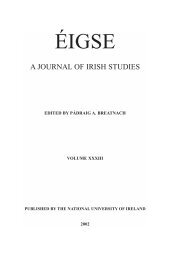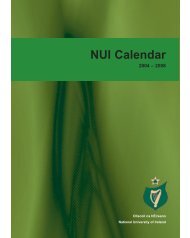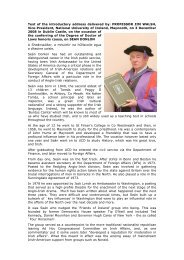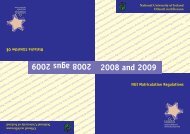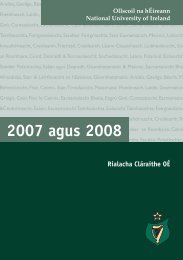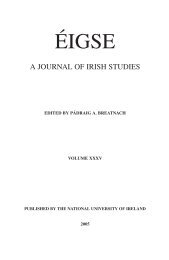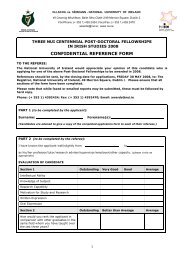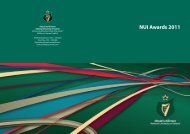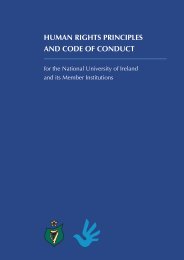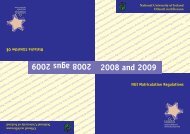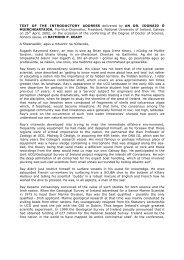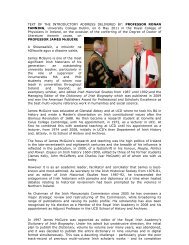Eigse Paged 2004 - National University of Ireland
Eigse Paged 2004 - National University of Ireland
Eigse Paged 2004 - National University of Ireland
You also want an ePaper? Increase the reach of your titles
YUMPU automatically turns print PDFs into web optimized ePapers that Google loves.
AILBE’S SPEECH TO CITHRUAD 7<br />
effecting a slight emendation <strong>of</strong> on to on[g] (gen. pl.), which<br />
results in a figura etymologica meaning ‘because <strong>of</strong> the tribulations<br />
that oppress me’.<br />
13 Bangnīma menma: ‘the mind <strong>of</strong> woman’s deed’, that is ‘the mindful<br />
deed <strong>of</strong> a woman’. In this construction the attributive notion is<br />
shifted towards the head-noun (GOI §250a).<br />
fri tuind trebairi: If we take tonn in the rare sense <strong>of</strong> ‘land, soil’<br />
(DIL T 248.36-40), this can be taken as a case <strong>of</strong> attraction <strong>of</strong> a<br />
preposed genitive to the case required by the preceding preposition<br />
thus creating hendiadys: ‘to soil (and) tillage’ = fri trebairi<br />
tonnae ‘to tillage <strong>of</strong> the soil’. See Wagner 1982 on this construction.<br />
For an example <strong>of</strong> independent occurrence in two early texts<br />
see Corthals 1995: 119-120 (di thúathaib táirgiuth ‘from the<br />
people’s supply’). It remains doubtful, however, if all such examples<br />
are genuine. They may be partly due to scribal intervention<br />
(Breatnach 1981: 75-76).<br />
17 remchisin: If the dot over c in the manuscript really indicates lenition,<br />
the resulting remchisin for remcisin could be explained as a<br />
case <strong>of</strong> recomposition after the example <strong>of</strong> compounds with rem-<br />
(e.g. remf·ocul). But as lenition <strong>of</strong> voiceless spirants is otherwise<br />
not indicated by a suprasegmental mark in our text, I doubt if this<br />
reading is correct.<br />
19 fri cairp[th]i: The underlying form <strong>of</strong> MS cairpi is cairpthi (on<br />
the omission <strong>of</strong> th see the introduction), a Middle-Irish equivalent<br />
<strong>of</strong> O. Ir. cairptiu.<br />
fri cluræ cræslīnad: I cannot find any sense in cluræ. If the<br />
abbreviation stroke for ur should have been miswritten for a<br />
straight stroke, the abbreviated form could have been for cléræ,<br />
gen. sg. <strong>of</strong> clíar ‘company, band’ which makes perfect sense in<br />
this context.<br />
20 fri daiddingmāil c[h]éle: On daid- for dag- compare daidben for<br />
dagben later on in Tochmarc Ailbe (Thurneysen 1920-21: 266, l.<br />
17). In view <strong>of</strong> the next line (‘to concord and contemporaries’) I<br />
would understand dingbáil in its derived meaning ‘being a match<br />
for’ rather than in its original sense <strong>of</strong> ‘removing, repelling’ (DIL<br />
D 127. 68ff).<br />
21 fri cuib[d]i 7 comæsa: Both cuilus (so Thurneysen) and cuibi are<br />
possible readings, but, whereas cuilus gives no sense, cuibi can be<br />
seen as a modern reading for older cuibdi ‘fitness, harmony’ (see<br />
my introductory remarks on the orthography). The manuscript<br />
reading comæsArom suggests that A was felt as belonging to the



